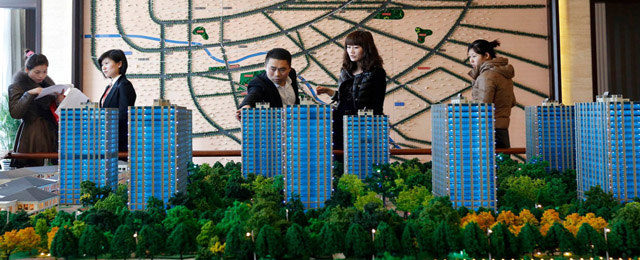GDP targeting no longer serves a good purpose. It sends a dangerous signal for resisting economic restructuring and sustaining speculation. Continuation of GDP targeting would lead to an economic hard landing and massive non-performing loans.
The recent upturn in GDP growth is not good news for China. It has occurred by further increasing the economic imbalance and prolonging speculation. It merely delays the inevitable economic restructuring and increases its final cost.
The bursting of the property bubble is a necessary step in China’s economic restructuring. It decreases funding for investment and increases it for consumption. Prolonging the property bubble is equivalent to resisting economic restructuring.
Delaying tactics in prolonging the bubble are effective for the time being. The Fed has delayed the tapering of quantitative easing, triggering the return of hot money. It sustains China’s shadow banking system, which is the lifeline for the property bubble. One should use the opportunity to deflate the bubble to avoid a forced – and bigger – bursting later. India and Indonesia have increased interest rates, despite the breathing space. China has chosen to light up the bubble once more.
Market forces are likely to trigger China’s bubble to deflate again, following the 2012 downturn, within six months. Liquidity will be squeezed between demand from growing fixed-asset investment and downward pressure due to the Fed tapering. The available liquidity for the property bubble will decrease as a consequence.
Further, China’s credit creation increasingly depends on the shadow banking system. The higher interest rate in its credit creation makes the property bubble unstable. Even if the liquidity squeeze does not pop the bubble, the breakdown in credit circulation, due to fears of underlying asset quality, may do the bubble in anyway, just like in the United States in 2008.
The Inevitable Restructuring
China’s economy will have to go through restructuring. It is not a choice. It will happen either under government leadership or market pressure. In the later scenario the process could be quite chaotic.
The 2008 Global Financial Crisis signaled the end of China’s rapid export growth. China’s policy response misread the situation and launched a massive investment push. As exports have failed to rise afterward, China is facing tremendous overcapacity. To support GDP growth, investment continues to rise faster than GDP, though slower than before. This means overcapacity is increasing. Unless exports surge to absorb overcapacity, investment has to slow and grow less than GDP, which is a necessary condition for solving overcapacity. As investment is over half of GDP, its slowdown will inevitably cause a general economic slowdown.
Since 2007, China’s investment-to-GDP ratio has risen by over 10 percentage points, while the export-to-GDP ratio has fallen by over 10 percentage points. The 20 percentage points in the deviation of the trends suggest how massive China’s over-investment situation is now.
China always has pursued an investment-led growth strategy. It worked because exports followed to fill the capacity. The net cost is the waiting time between capacity formation and export demand, i.e., the return on capital is low. This is why the stock market has not rewarded investors in the past two decades, even though the nominal GDP has risen twenty times.
The global environment has changed since 2008. The income weakness and high unemployment rates in developed economies imply weak Chinese exports for many years to come. This means China’s export-to-GDP ratio will not rise rapidly to catch up with the investment-to-GDP ratio. The only way out is for the latter to fall, i.e., China’s investment-to-GDP ratio needs to decline by 20 percentage points.
Speculation Isn’t the Solution
Speculation, especially in the property market, has supported China’s investment surge despite export weakness. It essentially increases the savings rate and boosts the paper return on capital.
Any investment bubble needs two elements to sustain it. First, there must be return on capital through price appreciation. By definition, an investment bubble causes overcapacity and decreases the cash return on capital. The only way to attract money is for the asset price to increase, i.e., the asset goes up in value while its income goes down. Controlling land has become the main motivation for industrial investment. The declining cash return in many industries has not deterred investment for this reason.
Second, an investment bubble requires a rising savings rate. The property bubble has played this role in China. When an investor or speculator buys a property, over half of the money goes to the government. The money is then channeled into investment. The rising ratio of property sales to GDP is effectively a rising savings rate.
China’s property bubble is at the heart of its over-investment problem. If it deflates, the investment-to-GDP ratio will probably drop by 10 percentage points or half of China’s required restructuring.
*Read the full article at Caixin magazine.
**Photo by Kim Kyung-Hoon/Reuters.






Be the first to comment on "China’s Property Bubble: Pick Your Poison"